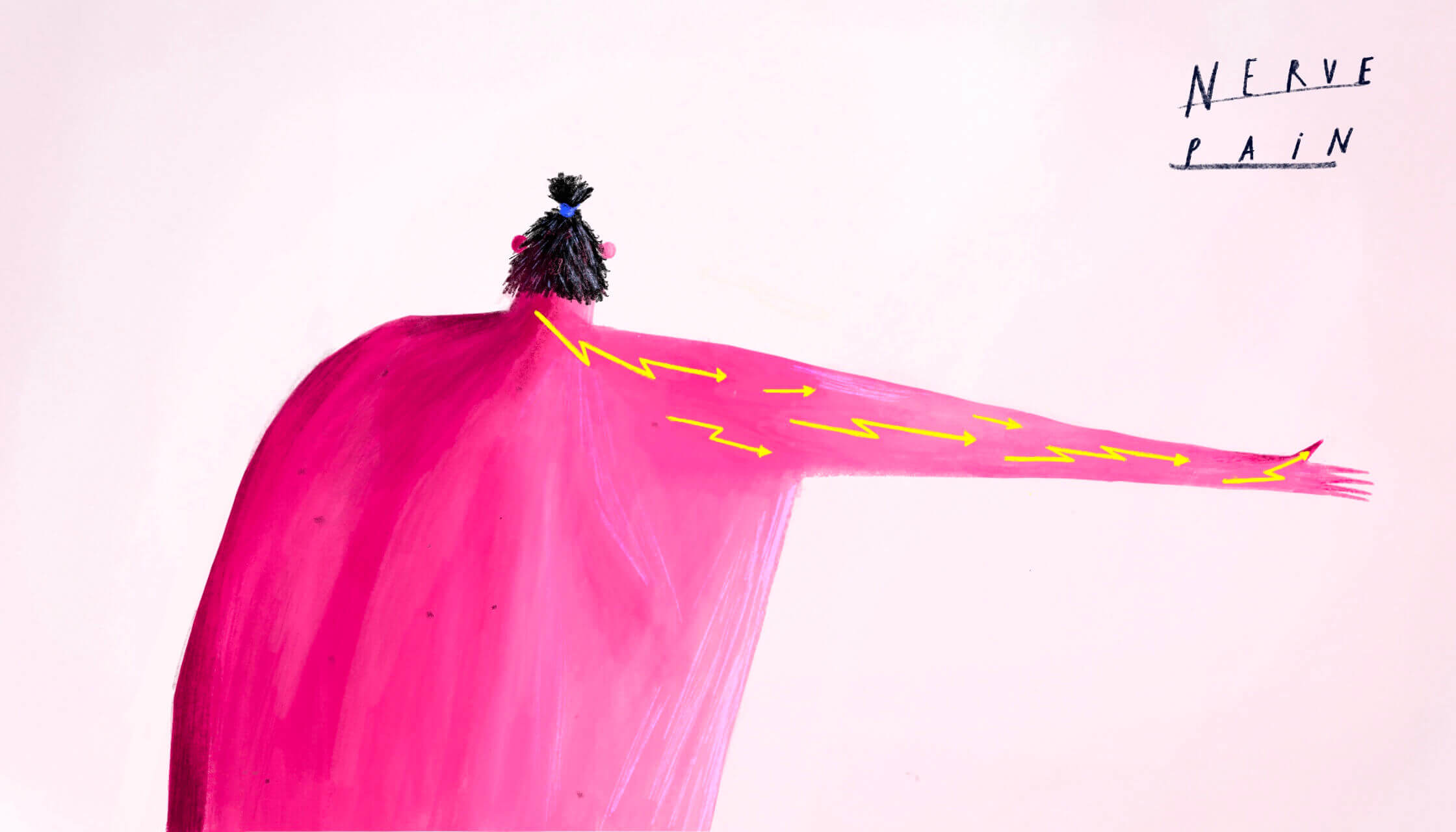Nerve pain
or pins and needles in the arms or legs
Find out more about nerve pain or pins and needles in the arms or legs

Neurosurgeon Brisbane
Nerve pain key points
- Sciatica is a medical term for nerve pain down the back of the leg.
- You can also get nerve pain down the front of the leg. We call it femoratica.
- Neurogenic claudication is due to multiple nerves in the lower back being jammed causing aches and pins and needles down both legs, particularly bad when walking.
- You can also experience nerve pain in your arms. It is called brachialgia.
- Nerve pain is often treated with a simple steroids injection, pilates or physiotherapy.
- There are only 3 reasons why you would need surgery to treat nerve pain and I’ll explain these below.
Nerve pain Brisbane
What is it?
When the nerves of the spine get irritated or squashed, nerve pain results.
It is quite common.
- When this nerve pain goes down the back of the leg it is called sciatica.
- When it goes down the front of the leg it is called femoratica.
- When it goes down the arm it is called brachialgia.
The spaces in the spine where the nerves run are very small to start with. Therefore, it doesn’t take much to irritate or squash them. Usually, a small bit of arthritic tissue is the cause. The resulting pain is disproportionate, however. For only a few millimetres, the resulting nerve pain can be horrific.

Nerve pain specialist Brisbane
Pins and needles are similar to pain, also a sign of nerve root being irritated or squashed. Often patients have both. Usually, the pins and needles occur in the hands or feet and the pain spreads right down to the ankles or the wrists.
Nerve pain is quite common. Many people have heard of sciatica or sciatic nerve pain; the type of nerve pain down the back of the leg. Often they also have pins and needles in their feet (though they often don’t notice this because the pain is so bad it distracts from everything else).
Nerve pain symptoms
What are the symptoms?
It is usually only the nerves in the back and neck that cause nerve pain.
If it is in the back, there are only two nerves affected; the sciatic nerve or the femoral nerve.
- If it is the sciatic nerve, you will experience pain in the back, radiating to the buttock, down the hamstring and into either the side or the back of the calf. Often there is numbness and pins and needles in the foot.
- If it is the femoral nerve, the pain starts in the buttock and radiates around into the front of the thigh. Often there is numbness and pins and needles down into the front of the knee and into the shin bone.
If it is in the neck, the pain often radiates from the side of the neck, into the shoulder blade, and then down the side of the shoulder. There is often numbness and pins and needles in the hand.
Most of the time it is just one nerve affected.
There is another condition called neurogenic claudication. This only occurs in the lower back and involves compression of both the sciatic and femoral nerves inside the spine. For reasons that are not important here, it doesn’t cause actual nerve pain, but rather an aching feeling down both the front and back of the legs with pins and needles everywhere. Patients just say “I just feel it’s all over my legs, everywhere.” Also, it is classic in this condition to hear patients say it only gets worse when walking and better when resting.
Nerve pain causes
What causes it? Did I do something to cause it?
The most common cause is wear and tear changes in the spine. Often the nerve has been squashed by arthritic tissue or a bulging disc for a long time and it’s only when one day that you do something that jams the nerve further that the pain and symptoms all start.
It’s a bit like having your hand caught in the cookie jar: you don’t feel any pain until you start trying to yank your hand out, and your hand gets all battered, bruised and sore.
It’s very common to hear stories like:
- “I was fine then I lifted something and twisted and bang! It all started”
- “I just sneezed and wham!”
- “I thought I felt funny and now I have this awful pain in my neck and arm”
It’s quite common, and usually not dangerous. Sometimes the pain can be so severe it feels dangerous. And sometimes the nerve is so irritated and squashed that the muscles supplied by the nerve stop working (a sensation of weakness in the hand or foot), but rarely is it an actual dangerous medical condition.

Nerve pain specialist Brisbane
The only time it is dangerous is if the bowel and bladder function is affected. This serious and dangerous condition is called cauda equina. I would need to see you immediately if this was the case. The other dangerous condition is if the weakness has happened quickly and is quite noticeable. Again, I should see you immediately if this is the case.
You can test yourself.
- Sciatica weakness makes it hard to stand on your toes, or on your heels.
- Femoratica weakness makes it hard to squat.
- Brachialgia weakness (coming from the neck) makes it hard to do push-ups, lift things with your biceps and grip things with your hand.
Furthermore, the prognosis is good in most people. If you would like your situation fully assessed, then contact my team and I will go through this thoroughly with you
Usually no.
Nerve pain treatment in Brisbane
How is it treated?
Did you know that in most people with nerve pain, or pins and needles, the symptoms will burn out by about 1-2 months and they can return to normal activity?
Often a simple steroids injection and pilates or physiotherapy help also.
Why would anyone need surgery then if this is the case?
Nerve pain surgery Brisbane
Do I need surgery?
Most people don’t need surgery. Even though it is keyhole surgery (1-inch incision in the back only), recovery is very rapid (usually go home the same day) and there is no need for any rods, bolts or screws, most people will be fine with pilates, physiotherapy and a steroid injection.
There are only 3 reasons I operate for nerve pain:
- Sometimes the patient is in so much pain that they need it to end asap. In over 90% of cases a patient will wake up from surgery and the pain will already be gone. This is a very attractive option for some patients. Furthermore, the surgery does not weaken their spine and there are usually no restrictions post-surgery.
- Sometimes the weakness in the arm or leg is quite bad. Surgery gives the muscle the best chance of recovery by removing the compression off the nerve. Often patients don’t realise they have any weakness till I examine them closely.
- The third reason is if the symptoms have been dragging on and on and the patient can’t see any light at the end of the tunnel or just needs their life back on track. Again surgery will achieve this very quickly.
Ultimately it comes down to what your symptoms are, what I find on examination, what your scan looks like and what your current quality of life looks like. If you would like me to make this thorough assessment of your condition, please contact my team to book an appointment.
Usually, the condition burns itself out in the long run. It’s just about making you comfortable in the meantime. A steroid injection and physio or pilates can help with this. Or if you are in one or more of the categories listed above, nerve pain surgery will also work very quickly and safely.
Without nerve pain surgery it will be somewhat variable. On average it is between 1-3 months. Repeat steroid injections and frequent pilates or physio sessions will certainly keep you more comfortable during this period.
If you decide that your quality of life (or lack of!) warrants a keyhole procedure, then generally you will be out of hospital after 12-18 hours and back to normal activity by the 1st or 2nd week. The pain relief is usually instantaneous.
A steroid injection carries very little inherent risk. The only real risk is that it doesn’t work or that you need a second or third injection.
The risk of modern keyhole surgery for most causes of sciatica, femoratica, neurogenic claudication or brachialgia is less than 1% in my hands and is one of my subspecialties.
It is usually not a dangerous medical condition, just a very painful one. Whether you just rest it all comes down to your current quality of life. If you would like to discuss this further with me then contact my team here to book an appointment.
There are some things you can do to prevent this from happening again. When I see you I will go through this with you in detail specific to your case.
Usually yes. Once I have heard your symptoms, examined you and seen your scans, and you have told me about the quality of life and level of activity that you want to achieve, I can give you a better idea of what to do and the time frame involved.
Nerve pain specialist Brisbane
What should I do now?
If you are unsure about what treatment option is best for you, contact my team and book an appointment with me. We will go over your personal case and help you to make an informed decision.
Ready to make an appointment?
Ramsay Specialist Centre
Suite 325
Newdegate St
Greenslopes QLD 4120

